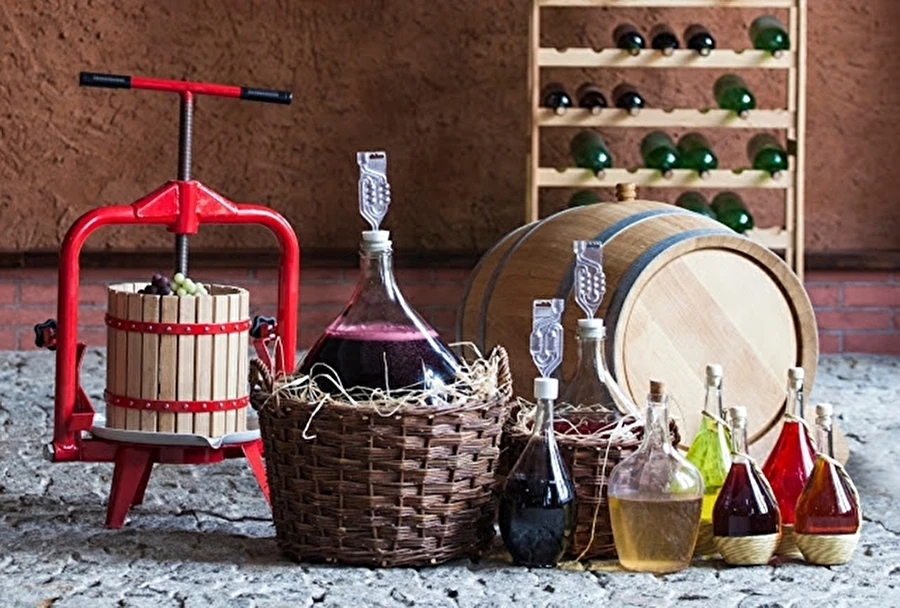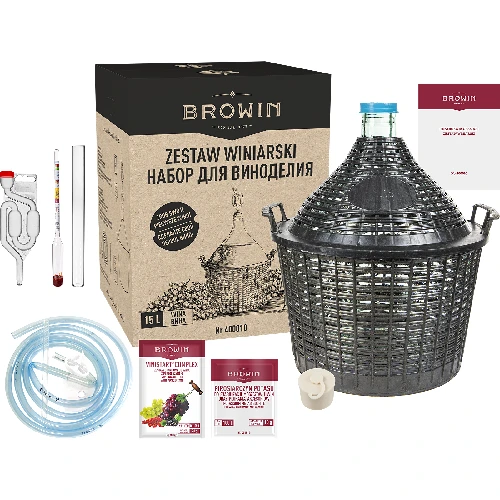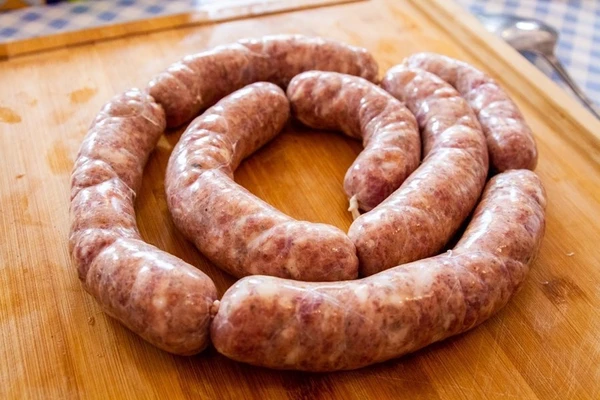The process of making home-made wine can be divided into several stages:
- Washing the equipment
You should remember that the winemaking equipment which you will be using should be perfectly clean and disinfected. This will prevent contamination, which could make the wine go bad. Potassium metabisulfite solution is used to disinfect winemaking equipment. Demijohns and other glass accessories should not be washed with hot water. Too high a temperature could cause the glass to break. Wooden accessories (e.g. spoons, stirrers) should be avoided, as they are a potential source of contamination.
- Preparation of mother yeast
Mother yeast is prepared 2 or 3 days before the planned fruit pressing. Pour about 150 ml of fruit juice into a 1-litre bottle, add 300 ml of water and 1 or 2 teaspoons of sugar. Cover the bottle with a cotton wool plug. Pasteurise the mixture for 20 minutes. After cooling it to room temperature, lift the cotton wool plug and add wine yeast (liquid yeast included in the set). Put the bottle in a warm place (approx. 26°C). The foam on the surface of the liquid and the release of CO2 mean that the yeast is proliferating. After 2 or 3 days, pour the proliferated mother yeast into the demijohn with the cuvée. A portion of the mother yeast should be enough for about 25 litres of must.
- Preparation of fruit must
Only sound and ripe fruit can be used to make wine. Wash and sort the fruit. Remove twigs and stems. Grain fruit, such as apples and pears, should be grated or crushed into smaller pieces. Seed fruit, such as strawberries, blackberries or currants, should be slightly crushed. Add the Pektopol enzyme preparation to the pulp - it facilitates the release of juice from the fruit pulp. Cover the mixture and set aside for a dozen or so hours. To separate the released juice you can use a non-metal sieve covered with gauze, or a comfortable wooden press.
- Preparation of must for fermentation
In order for the fruit must to ferment effectively, it should be properly flavoured by adding water, sugar syrup and yeast nutrient. After flavouring, pour the must into the demijohn and add the previously grown mother yeast. Finally, add the yeast nutrient. It will enable the proper yeast proliferation, quick start of fermentation, full fermentation, and, as a result, the proper concentration of alcohol and the right aroma of the wine. Close the demijohn with a stopper with a glass airlock, and set aside to a warm place. Do not forget to pour water into the glass airlock.
Remember!
1. When adding sugar, you should take into account the content of sugar in the fruit used. Remember that 1 kg of sugar is needed to obtain 0.6 l of alcohol. Sugar is always added to the wine in the form of cooled syrup (see “Glossary”). The sugar content of the must can easily be measured with a vinometer (saccharometer).
2. Most Polish fruit contain too much acid. The acidity is adjusted by diluting with water. Generally speaking, you should calculate how much water should be added to the must to get the acidity of 0.9%. Remember about the water added in the sugar syrup. More advanced winemakers are advised to buy an acidometer.
3. The exact amounts of sugar (water) to be added to the must can be found in the specific wine recipes. Most manuals on making wine at home provide detailed tables of the content of sugars and organic acids in various types of must.
- Must fermentation
The fermentation process can be divided into three stages:
1. Preliminary fermentation: lasts for about 2 to 3 days. During this stage the yeast develops rapidly and foam appears on the surface. Some winemakers recommend covering the demijohn with a cotton wool plug during this stage (it serves as a bacteriological filter limiting the access of microorganisms to the must, and allowing the penetration of oxygen, which stimulates the growth of the yeast). Gentle moving of the demijohn is also recommended. Mixing the contents of the demijohn distributes the yeast evenly and facilitates the access of oxygen and nutrients.
2. Effervescent fermentation: it lasts for a dozen or so days. The balloon is closed with a stopper with a glass airlock. The amount of sugar in the must decreases, and the level of alcohol increases (the yeast “converts” sugar into alcohol and carbon dioxide). The must froths very intensively and its temperature rises. Be careful! Yeast dies at the temperature higher than 28 °C. When the yeast dies, the fermentation stops. Therefore, you should especially careful (e.g. on hot summer days) to prevent the must from overheating. The end of turbulent fermentation is the right time to add more portions of sugar and nutrients (if you want to make sweeter wine and at the beginning, based on the selected recipe, you assumed adding sugar to the must in several portions).
3. After-fermentation (also called silent fermentation). The intensity of the reaction decreases. A small amount of carbon dioxide is released, the foam disappears, dead yeast accumulates at the bottom of the demijohn, and the liquid begins to clarify.
- Decanting young wine
The end of the carbon dioxide release and the appearance of yeast sediment at the bottom of the demijohn means the end of the fermentation process. It's time to decant (young) wine from above the sediment. Leaving the wine in the demijohn may result in its turbidity, colour change and deterioration of the taste. Light wines require faster decanting, especially when the fermentation is carried out at a high temperature. For convenience, it is assumed that wine is decanted:
· in case of light wines: in week 3-5,
· in case of medium (table) wines: in week 4-5,
· in case of strong (dessert) wines: in week 8-14.
A special siphon hose with a clamp, a glass tube with a side hole (which prevents sucking of the sediment from the bottom) and, optionally, a pump is used to decant wine. Place the demijohn with wine higher than the demijohn to which the wine will be poured (preferably of the same or slightly smaller capacity). Suck the wine through the hose and place the end of the hose in the dish positioned below. Remember to maintain hygiene - young wine can be easily contaminated. This is a good time to check the taste of the wine and make any adjustments (add sugar, honey, fruit juice, citric acid). Cover the decanted wine with a stopper with a glass airlock and set aside to a dark and not very warm (about 21 °C) place. After a few weeks, check whether the wine has become even more clear and whether a new sediment from dead yeast has formed at the bottom. If the sediment is clearly visible, it is worth decanting the wine once again. Wine can be decanted several times, until full clarity is obtained. However, you should remember that any contact of the wine with the air carries the risk of contamination.
- Wine maturing
Wine maturing is aimed at improving its taste and aroma. It should also stabilise the clarity of the drink. Wine can mature in the same containers in which it fermented. It is enough to fill up demijohns with wine and seal them. The time of wine maturing depends on its type. Light wines are ready for consumption after just 1 to 2 months, table wines should mature for six months, dessert wines are best after 2 to 3 years.
- Filtering and clarifying of wine
If the wine has not clarified itself, you should it gain the right transparency and colour. Sometimes, to remove turbidity it is enough to filter the wine in a funnel (put canvas, cotton wool or special filter paper in the funnel). Turbidity can also be removed easily and effectively using fining agents. Clarification is carried out at the lowest possible temperature. Remember to make a clarification test first (on a small amount of wine). Observing the reaction, you can properly choose the type and amount of the fining agent. Klarowin is the most popular and effective agent in the vast majority of cases. Use 5 to 20 g of Klarowin per 10 litres of wine. This agent is very safe and natural. Other fining agents include: acid gelatin (1-2 g per 10 litres of wine), tannin (0.5-1 g per 10 litres of wine), activated carbon (2-20 g per 10 litres of wine).
- Wine bottling
When the wine is fully clear and mature, it can be bottled. The bottles intended for storing wine (it is recommended to use dark glass bottles) should be washed thoroughly. You can decontaminate them with 70% spirit or a 2-3% solution of potassium metabisulfite (dissolve 20-30 g of metabisulfite in 1 litre of water). Use new corks to cover the bottles (old ones can be contaminated and carry foreign smells). We recommend small convenient corkers, which are available on the market, as they enable quick closing of several dozens of bottles in no time. The bottles can be marked with special labels stating the type of wine, its vintage and alcohol content.
- Wine ageing
Bottles are stored in a horizontal position (the cork should be completely immersed in wine), at a temperature of 10 to 12 °C. In such conditions, wine can age for several years. You should check periodically for leaks. The time of wine ageing depends on its type. Light wines age for a shorter time, stronger wines age longer.
- Wine preservation
Fully matured (properly prepared and stored) wine does not need to be properly preserved. However, sometimes the wine becomes turbid. Usually, this problem concerns young wines with less than 14% of alcohol content.
The following processes are used to preserve wine:
1. sulphation: add potassium metabisulfite (2-3 g per 10 litres of wine) to the demijohn, mix thoroughly, then filter the wine and pour it into bottles.
2. Pasteurisation: heat the wine bottles at 72 to 74 °C for about 30 minutes. Remember not to fill the bottles to the very top and secure the corks with wire or clips (heated wine increases its volume and can push the corks out of the bottles). Bottles should be immersed in water to a level above the wine surface.
3. increasing the alcohol content: spirit is a strong preservative of wine. To increase the alcohol concentration in wine by 3%, add 3x12 ml (36ml) of 96% spirit per each litre of wine.
WINE PROBLEMS
Sometimes, despite your efforts, the wine does not meet your expectations - it does nto have the right colour, fragrance or taste. These are defects or diseases of wine. The most common defects include:
- too low acidity of wine - add citric acid or mix the wine with other, more acidic wine.
- too high acidity - mix the wine with less acidic wine or add sugar, water and yeast while trying to re-ferment the wine.
- too low alcohol content - add a new, strengthened mother yeast and try to ferment the wine again at a slightly higher temperature of 22-24 °C.
- wine browning - age the wine for a longer time, then clarify and filter it, you can also pasteurise the wine or try sulphation (add 0.5-2 g of potassium metabisulfite per 10 litres of wine).
- no clarity - clarify the wine with Klarowin, you can also add spirit to the wine or pour the wine into a strongly sulphated vessel.
The above mentioned wine defects are relatively harmless and easy to remove. The situation is more complicated when we are dealing with wine diseases. When maintaining the hygiene and observing other principles given in this manual, the probability of their occurrence is very low.
OWN COMPOSITION
In the table below you will find a summary of the ingredient proportions to prepare fermentation in a 30-litre fermentation container. The average sugar and acid content of each fruit was used for the calculation. The same fruit may contain slightly more or less sugar or acids, depending on the plant variety, region of growth and sun exposure. Therefore, in order to precisely specify their content, we recommend using a saccharometer and an acidometer. As you gain experience, you will be able to decide what proportions to use when making wine from your own fruit. Remember that, when decanting wine, you always have the opportunity to make corrections by adding sugar, water or acidity regulator, depending on the needs.







 Cheese calculator
Cheese calculator



 Winemaking
Winemaking












